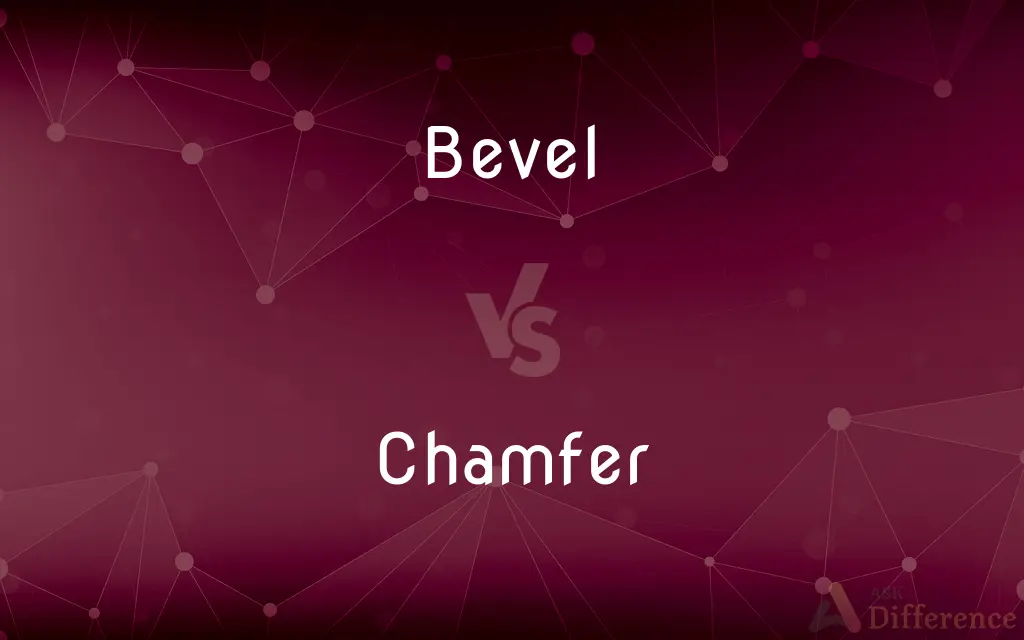Bevel vs. Chamfer — What's the Difference?
By Tayyaba Rehman — Updated on September 19, 2023
A "Bevel" is an edge cut at an angle other than 90 degrees, usually sloping. A "Chamfer" is also an angled cut on an edge but tends to be a 45-degree cut, often simpler and more utilitarian. Both are used in carpentry, machining, and design.

Difference Between Bevel and Chamfer
Table of Contents
ADVERTISEMENT
Key Differences
A "Bevel" is essentially an edge or surface that is not perpendicular to the faces of the piece. The angle and slope can vary according to the project's requirement. On the other hand, a "Chamfer" is specifically a cut that takes off the right-angle edge, generally at a 45-degree angle, to eliminate sharp corners.
Both Bevel and Chamfer serve specific functional and aesthetic purposes. In carpentry or machining, a Bevel might be used for better joinery or as a design element. A Chamfer, on the other hand, is generally used to simplify an edge or corner for safety or ease of assembly.
In terms of terminology, both "Bevel" and "Chamfer" are nouns when referring to the angle or edge itself. However, they can also be used as verbs, as in "to bevel" or "to chamfer," describing the action of making such an angled cut on a material.
While Bevel and Chamfer may seem similar, their applications can vary depending on the industry or the material in question. In woodworking, a Bevel is often considered a softer, more decorative feature, while a Chamfer is considered more utilitarian. In metalworking, however, Chamfers are often used to facilitate easier assembly of parts.
Comparison Chart
Angle
Variable
Generally 45 degrees
ADVERTISEMENT
Purpose
Often aesthetic or for joinery
Usually utilitarian
Grammatical Use
Noun and verb
Noun and verb
Application
Wood, metal, glass
Wood, metal
Complexity
Can be complex
Generally simpler
Compare with Definitions
Bevel
A sloping edge or face.
The bevel helped the pieces fit together seamlessly.
Chamfer
Typically a 45-degree angle cut.
The chamfer on the metal part allowed for easier assembly.
Bevel
A cut that deviates from a right angle.
The blade had a slight bevel for better cutting performance.
Chamfer
A cut that eliminates a right-angle edge.
The chamfer made the wooden box safer to handle.
Bevel
Used for both design and functional purposes.
The bevel in the wooden plank was both functional and aesthetically pleasing.
Chamfer
Often more utilitarian than decorative.
The chamfer on the plywood made it easier to handle.
Bevel
A feature in carpentry, metalwork, and design.
A bevel was added to the glass edges for safety.
Chamfer
Used in woodworking and metalworking.
The machinist added a chamfer to the edges of the gear.
Bevel
An angled surface cut on the edge of a material.
The bevel on the mirror added a decorative touch.
Chamfer
A chamfer or is a transitional edge between two faces of an object. Sometimes defined as a form of bevel, it is often created at a 45° angle between two adjoining right-angled faces.
Bevel
A bevelled edge (UK) or beveled edge (US) is an edge of a structure that is not perpendicular to the faces of the piece. The words bevel and chamfer overlap in usage; in general usage they are often interchanged, while in technical usage they may sometimes be differentiated as shown in the image at right.
Chamfer
To cut off the edge or corner of; bevel.
Bevel
The angle or inclination of a line or surface that meets another at any angle but 90°.
Chamfer
To cut a groove in; flute.
Bevel
Two rules joined together as adjustable arms used to measure or draw angles of any size or to fix a surface at an angle. Also called bevel square.
Chamfer
A flat surface made by cutting off the edge or corner of a block of wood or other material.
Bevel
To cut at an inclination that forms an angle other than a right angle
Beveled the edges of the table.
Chamfer
A furrow or groove, as in a column.
Bevel
To be inclined; slant.
Chamfer
An obtuse-angled relief or cut at an edge added for a finished appearance and to break sharp edges.
Bevel
An edge that is canted, one that is not a 90-degree angle; a chamfer.
To give a bevel to the edge of a table or a stone slab
Chamfer
(transitive) To cut off the edge or corner of something.
Bevel
An instrument consisting of two rules or arms, jointed together at one end, and opening to any angle, for adjusting the surfaces of work to the same or a given inclination; a bevel square.
Chamfer
(transitive) To cut a groove in something.
Bevel
(gambling) A die used for cheating, having some sides slightly rounded instead of flat.
Chamfer
The surface formed by cutting away the arris, or angle, formed by two faces of a piece of timber, stone, etc.
Bevel
(transitive) To give a canted edge to a surface; to chamfer.
Chamfer
To cut a furrow in, as in a column; to groove; to channel; to flute.
Bevel
Having the slant of a bevel; slanting.
A bevel angle
Chamfer
To make a chamfer on.
Bevel
Morally distorted; not upright.
Chamfer
Two surfaces meeting at an angle different from 90 degrees
Bevel
Any angle other than a right angle; the angle which one surface makes with another when they are not at right angles; the slant or inclination of such surface; as, to give a bevel to the edge of a table or a stone slab; the bevel of a piece of timber.
Chamfer
Cut a bevel on; shape to a bevel;
Bevel the surface
Bevel
An instrument consisting of two rules or arms, jointed together at one end, and opening to any angle, for adjusting the surfaces of work to the same or a given inclination; - called also a bevel square.
Chamfer
Cut a furrow into a columns
Bevel
Having the slant of a bevel; slanting.
Chamfer
Generally simpler than a bevel.
A chamfer is often easier to produce than a complex bevel.
Bevel
Hence: Morally distorted; not upright.
I may be straight, though they themselves be bevel.
Bevel
To cut to a bevel angle; to slope the edge or surface of.
Bevel
To deviate or incline from an angle of 90°, as a surface; to slant.
Their houses are very ill built, the walls bevel.
Bevel
Two surfaces meeting at an angle different from 90 degrees
Bevel
A hand tool consisting of two rules that are hinged together so you can draw or measure angles of any size
Bevel
Cut a bevel on; shape to a bevel;
Bevel the surface
Common Curiosities
Are Bevel and Chamfer interchangeable?
No, they serve different purposes and are generally cut at different angles.
Can Bevel and Chamfer both be verbs?
Yes, both can be used as nouns to describe the edge and as verbs to describe the action of cutting.
Is a Chamfer always 45 degrees?
While commonly 45 degrees, chamfers can be at different angles depending on the application.
Why would I use a Bevel instead of a Chamfer?
A Bevel is often used for aesthetic purposes or specific joinery, while a Chamfer is usually more utilitarian.
What is a Chamfer?
A Chamfer is a cut that eliminates a right-angle edge, typically at a 45-degree angle.
Is a Bevel more complex than a Chamfer?
Generally, a Bevel can be more complex due to its variable angle and purpose.
Is Beveling common in woodworking?
Yes, beveling is commonly used in woodworking for both functional and decorative purposes.
What tools are used for Chamfering?
Chamfering is typically done using routers, chamfer planes, or milling machines.
What is a Bevel?
A Bevel is an angled surface cut on the edge of a material.
Can I Chamfer an edge using software?
Yes, many CAD programs have features that allow for virtual chamfering.
Are Chamfers more common in metalworking?
Yes, Chamfers are often used in metalworking to facilitate easier assembly.
Can you Chamfer glass?
Generally, glass is beveled rather than chamfered, although it is technically possible.
Is Chamfering common in woodworking?
Yes, but it is generally used for simpler, more utilitarian purposes.
Can I Bevel an edge using software?
Yes, many design software options allow for virtual beveling in models.
What tools are used for Beveling?
Beveling can be done using a variety of tools like bevel squares, routers, or specialized beveling machines.
Share Your Discovery

Previous Comparison
Unvetted vs. Vetted
Next Comparison
Congress vs. ProgressAuthor Spotlight
Written by
Tayyaba RehmanTayyaba Rehman is a distinguished writer, currently serving as a primary contributor to askdifference.com. As a researcher in semantics and etymology, Tayyaba's passion for the complexity of languages and their distinctions has found a perfect home on the platform. Tayyaba delves into the intricacies of language, distinguishing between commonly confused words and phrases, thereby providing clarity for readers worldwide.















































